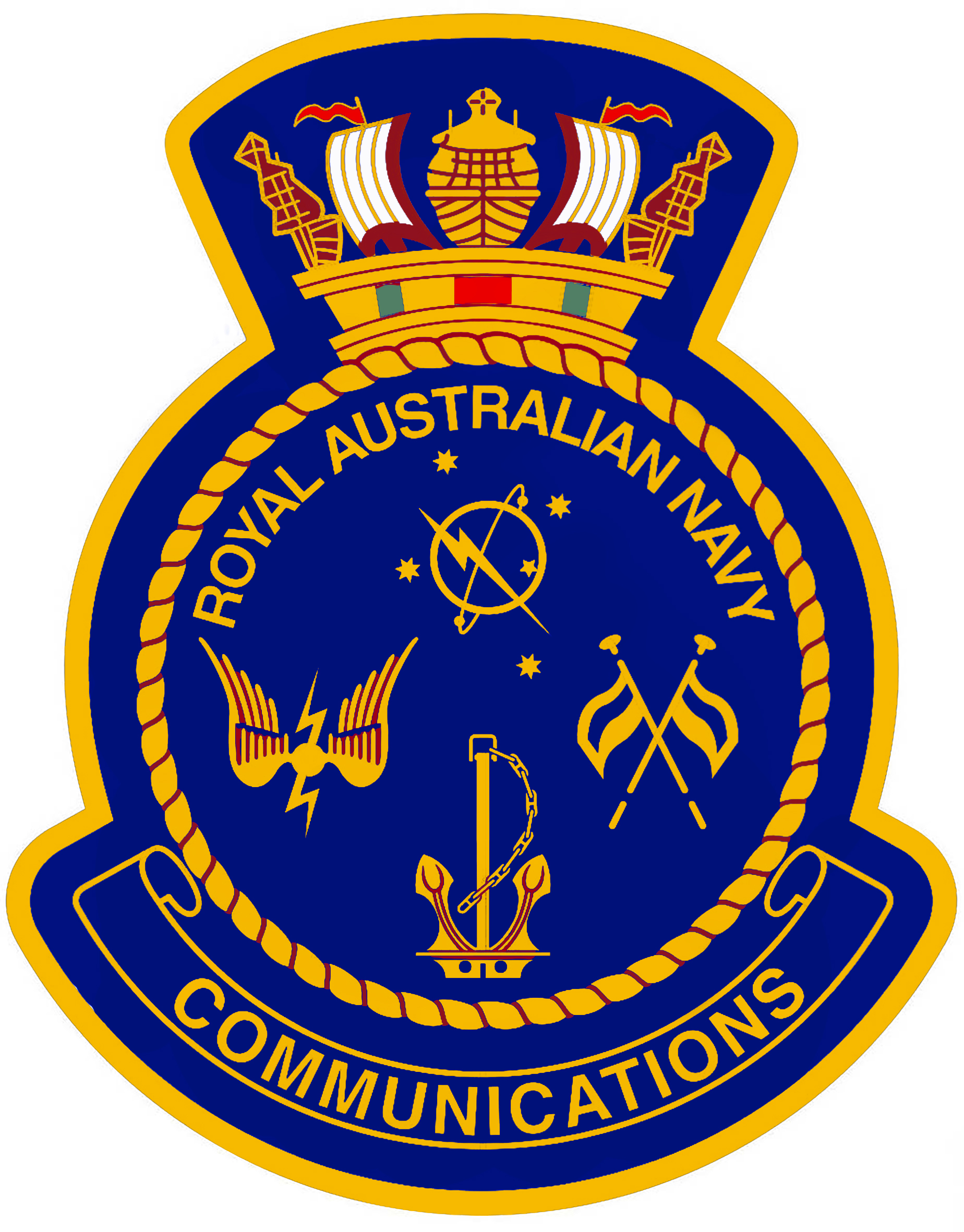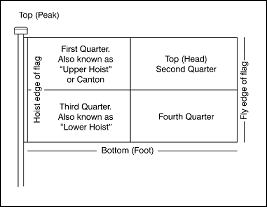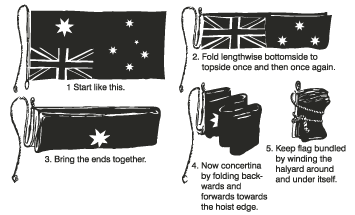HISTORY OF THE AUSTRALIAN NATIONAL FLAG (ANF)
Surprisingly it was not until 1953 that our flag was officially proclaimed the Australian National Flag.
With Federation and the joining of all Australians under the Commonwealth of Australia, there came a real need for a flag to unite the peoples of the six colonies.
In 1901, a world wide competition was held to find two new flags: one suitable for official and naval purposes, and another suitable for the Merchant Navy Service. The Commonwealth, “The Review of Reviews”, (a newspaper of the day), and the Havelock Tobacco Company forwarded prize money totaling 200. The response to the competition was excellent.
Over 30,000 flag designs were presented for display in the Exhibition Building in Melbourne in September, 1901. From the 30,000 entries the choice was narrowed to five. It was decided that the five would share the prize money. The winners were Mrs. A. Dorrington of Perth, Mr. I. Evans of Melbourne, Mr. L. Hawkins of Sydney, Mr. E. J. Nuttall of Melbourne and Mr. W. Stevens of Auckland.
A flag embodying the five winning designs was proudly flown in the Exhibition Building in Melbourne on the day that the Prime Minister, Mr. E. Barton, announced the winners. The flag was very like the flag that became the Australian National Flag 52 years later.
In the upper hoist was the Union Jack, made up of the crosses of St. George, St. Andrew and St. Patrick. Beneath the Union Jack was a large six pointed star representing the six states and in the fly of the flag, five stars symbolizing the Southern Cross.
The Union Jack reflected our heritage, the large six pointed star indicated the unity of the six States within the Commonwealth of Australia and the Southern Cross reflected Australia’s place in the universe. A flag showing our history, our unity and our independent position.
In 1903, King Edward approved designs for the flag of Australia and the flag of the Merchant Navy. They became known as the Commonwealth Blue Ensign and the Commonwealth Red Ensign.
In 1908 the six pointed star became a seven pointed star, the seventh point added to represent current and future Territories of the Commonwealth. The new seven pointed star conformed with the star in the Crest of the Coat of Arms.
In the early years of the Commonwealth, the flying of the ensigns was not encouraged, but a new body of thought developed through Prime Minister Menzies in 1941 and was supported by Prime Minister Chifley in 1947. The flying of the Commonwealth Blue Ensign was encouraged on shore provided it was flown in a manner befitting the national emblem of our country.
In 1951, the Australian Government recommended that King George VI approve the Commonwealth Blue Ensign as the National Flag. At this stage there was still no official recognition for the ensign as our National Flag.
King George gave his approval and in 1953 the Flags Act proclaimed the Australian Blue Ensign as our national flag and the Australian Red Ensign as the correct colours for Australian registered merchant ships.
We properly call these flags the Australian National Flag and the Australian Red Ensign.
The Royal Australian Navy has as its official ensign the Australian White Ensign, and the Royal Australian Air Force has as its official ensign the Ensign of the Royal Australian Air Force. The official flag of the Australian Army is the Australian National Flag.

The Australian National Flag

The Australian Red Ensign
The flag that Flags 2000 is so proud to manufacture is red, white and blue with the Union Jack in the upper hoist, a large seven pointed star directly below the centre of the Union Jack in the lower hoist and five white stars representing the Southern Cross in the fly of the flag.
The large star in the lower hoist represents the States and Territories with a point for each State and a joint point for the Territories.
Four of the stars of the Southern Cross, Alpha, Beta, Gamma and Delta have seven points on the flag to uniform the design and for aesthetic appeal. Epsilon, the fifth star, is represented by a five pointed star because it is not as bright as the others in the constellation.
The length of the flag is always twice the width of the flag. For example, a flag 1800mm (or 6 feet) long is always 900mm (or 3 feet) wide. 1800mm x 900mm flags are recognized as the most popular size, suitable for standard flagpoles, 6-8 metres high (18-24 feet).
The Australian Red Ensign, the flag for merchant vessels registered in Australia, is predominantly red. In all other respects it is the same as the Australian National Flag.
The Australian National Flag must be accorded the dignity required by a national symbol and as such, correct procedure should be followed.
We note a few points that may assist in the flying of the flag, and following these, an illustrated guide to help citizens, clubs, large organizations and companies correctly and effectively display the flag.
The flag should be flown aloft and free, with all parts of the flag able to be seen readily.
It should be raised quickly and lowered slowly and ceremonially.
It should be well illuminated if it is to be flown at night.
It should be flown on all Commonwealth Government buildings during working hours.
It is encouraged that companies and private citizens also fly the Australian National Flag.
When the Australian National Flag is flown with flags of other sovereign nations, it should be of the same size and fly at the same height as all other flags.
If more than one flag is flown, each flag should fly on a separate flagpole with the Australian National Flag taking the place of honour.
The Australian National Flag should be the first flag raised and the last flag lowered, unless the number of flags and attendants allows them to be raised and lowered together.
The large star in the lower hoist represents the States and Territories with a point for each State and a joint point for the Territories.
Four of the stars of the Southern Cross, Alpha, Beta, Gamma and Delta have seven points on the flag to uniform the design and for aesthetic appeal. Epsilon, the fifth star, is represented by a five pointed star because it is not as bright as the others in the constellation.
The length of the flag is always twice the width of the flag. For example, a flag 1800mm (or 6 feet) long is always 900mm (or 3 feet) wide. 1800mm x 900mm flags are recognized as the most popular size, suitable for standard flagpoles, 6-8 metres high (18-24 feet).
The Australian Red Ensign, the flag for merchant vessels registered in Australia, is predominantly red. In all other respects it is the same as the Australian National Flag.
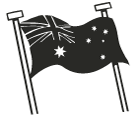
When the Australian National Flag is flown alone in front of an establishment where there are two flagpoles, it should be flown on the flagpole on the left as one faces the flag.
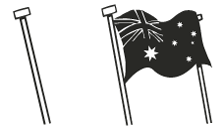
If there are more than two flagpoles, it should be flown in the centre, or as near to the centre as possible. This is so whether the flagpoles are positioned in the grounds or on top of buildings.
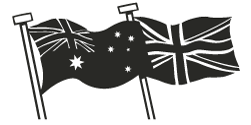
When the Australian National Flag is flown with flags of other sovereign nations, the Australian National Flag takes the prime position. If it is flown with one other flag of a sovereign nation, the Australian National Flag should be on the left as one faces the flags.
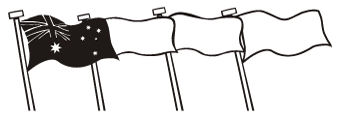
If the total number of flags is even, the Australian National Flag should be flown on the left as one faces the flags in front of an establishment. If the total number of flags flown is odd, the Australian National Flag should be flown in the centre.
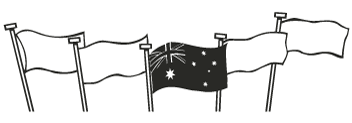
If the flagpoles are arranged in a semi-circle, the Australian National Flag should fly in the centre of those of other sovereign nations.
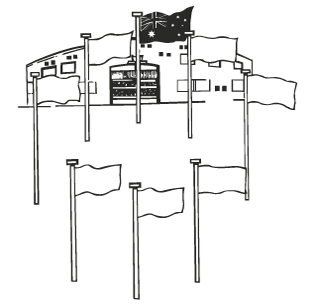
If the flagpoles are arranged in a complete circle, the Australian National Flag should fly opposite the entrance of the building, the arena or other structure responsible for the display.
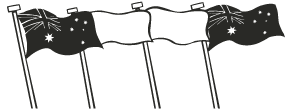
If there are two Australian National Flags available, one should be flown at either end of those of other sovereign nations.

If the Australian National Flag is flown with flags that are other than those of sovereign nations, it should fly on the left as one faces the flagpoles. For example, it could be flying with State flags, pennants, flags representing clubs and so on. If there are two Australian National Flags available they should fly at either end of the other flags, each on its own separate flagpole.
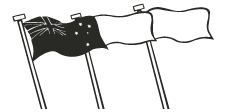
In a procession, the Australian National Flag should always take the lead, or have the prime position.
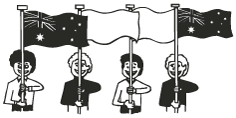
If carried in a line as shown above, the Australian National Flag should be carried at either end.
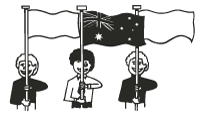
If there is only one flag available, then the Australian National Flag should be carried in the centre if the total number of flags is odd. If the total number of flags is even, it should be carried by the marches on the left as one faces the marchers.
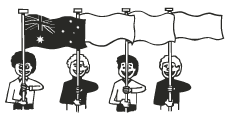
If the Australian National Flag is to be displayed on a wall, the upper hoist of the flag should be on the left as one faces the flag, no matter whether the flag is suspended horizontally or vertically.
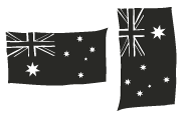
If the Australian National Flag is to be displayed on a horizontal rope across a street, it should face north in an east-west street, and east in a north-south street. The flag will thus be on the left of one facing east or south respectively.
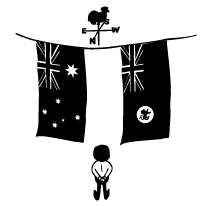
If it is desired that the Australian National Flag cover a casket or a coffin, the upper hoist should be draped over the left shoulder of the deceased. The flag should be taken from the casket before burial or cremation.
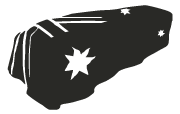
- The Australian National Flag should not be permitted to lie upon the ground.
- It should be correctly fastened so that it will not: fall on the ground.
- It should not be used to hide spaces that may exist between the floor and the lower level of a desk, dais or platform.
- The Australian National Flag should not be employed as a cover for statues or monuments.
- It should not be used as a cover for a plaque or such at an unveiling ceremony.
- It should not be used as a cover for tables or chairs.
- The Australian National Flag should not be defaced by any object or badge attached or superimposed on it.
- It should not be flown together with the Australian Red Ensign.
The responsible Government Minister directs that the Australian National Flag be flown at half mast as a sign that the country is in mourning.
To achieve the half mast position, the flag should be raised to the top of the flagpole, then in a continuing movement, lowered slowly to half mast. It is important that the flag appears to be at half mast and not to have fallen away from the top of the flagpole. This will generally be attained when the top of the flag is one third of the total length of the flagpole from the top.
Before lowering the flag for the day, it should be raised once again to the top of the flagpole and then lowered slowly to the ground.
If a period of mourning is desired by local authorities in particular municipalities or towns, it is correct for the Australian National Flag to be flown at half mast on the building within which the deceased is lying in state. It should be raised when the deceased is no longer lying in state.
1. Start like this (see below).
2. Fold lengthwise bottomside to topside once and then once again.
3. Bring the ends together. 4. Now concertina by folding backwards and forwards towards the hoist edge. 5. Keep flag bundled folding backwards by winding the halyard around and under itself.
